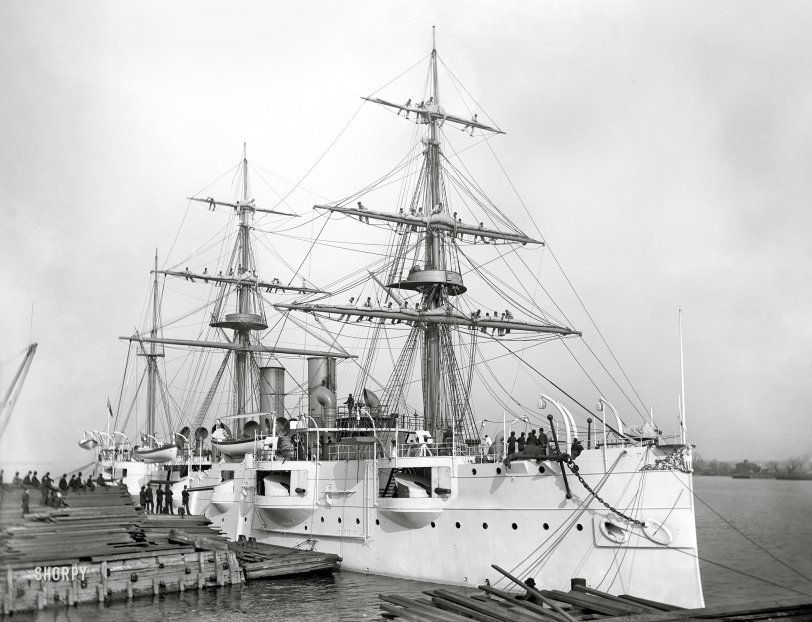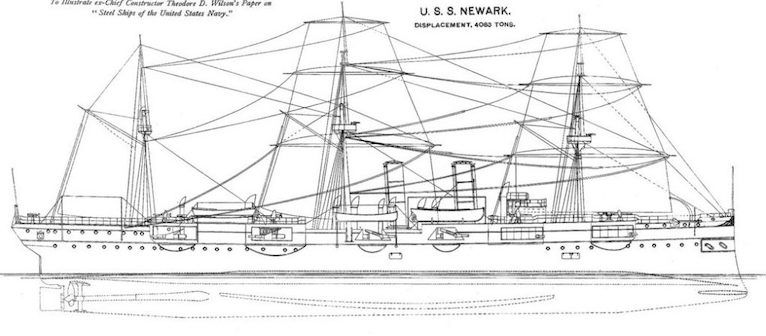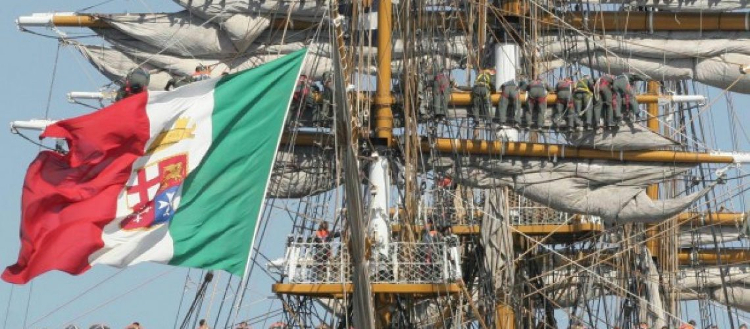


Framed or unframed, desk size to sofa size, printed by us in Arizona and Alabama since 2007. Explore now.
Shorpy is funded by you. Patreon contributors get an ad-free experience.
Learn more.

- Baldwin 62303
- Baldwin VO-1000
- Cold
- No expense spared
- Tough Guys
- Lost in Toyland
- And without gloves
- If I were a blindfolded time traveler
- Smoke Consumer Also Cooks
- Oh that stove!
- Possibly still there?
- What?!?
- $100 Reward
- Freeze Frame
- Texas Flyer wanted
- Just a Year Too Soon
- WWII -- Replacing men with women at the railroad crossing.
- Yes, Icing
- You kids drive me nuts!
- NOT An Easy Job
- I wonder
- Just add window boxes
- Icing Platform?
- Indiana Harbor Belt abides
- Freezing haze
- Corrections (for those who care)
- C&NW at Nelson
- Fallen Flags
- A dangerous job made worse
- Water Stop
Print Emporium
Rigged: 1900

Circa 1900. "Cruiser U.S.S. Newark." 8x10 inch dry plate glass negative, Detroit Photographic Company. View full size.
Mighty Sailing Adventure
These comments and amazing photo reminded me of the incredible Cinemiracle movie from 1957 called 'Windjammer' - a Norwegian cadet training ship built at the turn of the 20thC.
If you haven't seen it and admire the romance, crew skills and beauty of sailing ships, I thoroughly recommend getting a copy on Bluray (make to sure to get the latter restoration ca 2017 version)
Ramming speed
The reason the Newark didn't have a clipper-type curved bow is that she sported an armored ram just below the waterline. Many of the U.S. Navy's early steel warships included this design feature, which was of dubious value in actual combat.

Where's the soot?
Amazing how the mainmast is not totally soot-covered from being located immediately behind the stacks - the crew must keep busy keeping the mainmast and mizzenmast (and all the related yards, sails and crow's nests) clean!
Royal Caribbean white
Probably not the most practical color for a naval vessel, especially when crowned with ochre topsides and bituminous black smoke. Practicality is not paramount in 1900: the iron men of the secondary gun crews need no armor protection below the waist. The roof armor of the casemates is angled to deflect splintered projectiles into the bottoms of the overhanging boats. Floating boats would be handy should you win second place in a gunnery duel.
Old fashioned
Climbing the masts and manoeuvring the sails is still part of the training of the Italian Navy academy cadets. Here the future officers undergoing exercise aboard Vessel Amerigo Vespucci.

Pointy ends
I've long wondered why the bow in those days was nearly vertical and what kind of thinking went into that design. Prior sailing ships always had a sloping bow as did later Navy vessels. But this era had a much different profile.
... and I have my own harrowing tale of touching the very top of USS Gridley while in the Long Beach shipyard, circa 1983.
Nice!
This is the nicest-looking thing called 'Newark' that I have ever seen. Of course, the views from the coal bunker and the powder magazines were probably less gratifying.
Rigging
As a 12 year old, I would have loved to go climbing up to the top. By the time I got to my 20s, and was doing a lot of sailing, climbing the rigging had lost its allure.
Me timbers would be shivering
You know what? I'll pass on climbing up that mast to even the lowest spar and then walking out along a rope so I can balance on that rope while working with heavy sail canvas. I think I'll just stay down here and swab a deck.
High Wire Act
I wonder how many men got their aerial training in the U. S. Navy before resigning to join Ringling Brothers Barnum & Bailey Circus.
Stepping on!
Having worked on several square-rigged vessels when I was younger, I can honestly say standing on the foot-ropes and making your way out to the end of the yard on the t'gallant (topgallant, third yard up) to furl or let loose sail is fun. We'd wear safety harnesses ... these men didn't. For safety, you'd let the others already out there know that you were about to "step on" -- the added weight lifts the closest guy to you up a bit and can be bit of a surprise if he isn't expecting it.
























On Shorpy:
Today’s Top 5